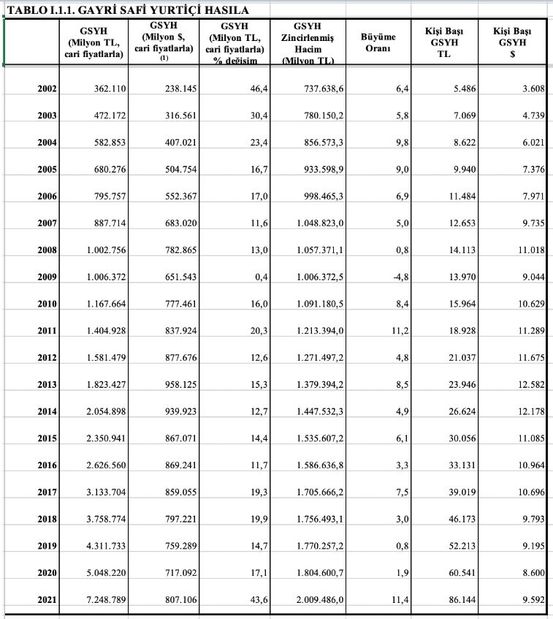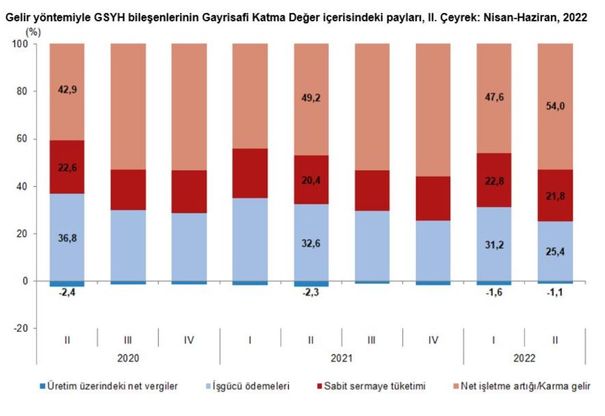The growth for the second quarter of the year was 7.6 percent. First-quarter growth was also revised to 7.5 percent. There is very little work left in the second half to achieve high growth throughout the year. At this rate, annual growth of 5.5-6 percent is easily achieved.
➔The 2021 growth, which was calculated by 11 percent on the data announced by the quarters before, was announced on an annual basis and became 11.4 percent. Independent annual gross domestic product (GDP), calculated based on annual data, grew 11.4% with the chained volume index.
➔Thus The record of a period of more than half a century was broken. Before last year, 2011 had a growth record of 11.2 percent. There is no other double-digit growth in the time period that goes back to 1976. That year’s growth was 10.5 percent, lagging behind 2011.
GROWTH RECORD OF 55 YEARS BROKEN IN 2021
➔There is a high growth rate of 11.7% in 1966. Here is the growth of 11.4 percent in 2021, the highest growth after 1966 and the record for 55 years.
➔Turkey’s 2021 GDP also increased by $5 billion to $807.1 billion. Per capita income rose to $9,562.
➔ As of the middle of this year, the amount of GDP increased to 827.7 billion dollars in the last four quarters. Despite the increase in the dollar exchange rate GDP increased by 20 billion dollars in the first half of the year.
➔Per capita income also rose to $9,690 per year compared to the average annual population.
➔Looking at the latest growth data in the second quarter, it is necessary to underline a few important developments.
➔Let’s start with the positive one machinery and equipment investments increased by 17.8 percent. A higher increase compared to the last two quarters indicates that investments accelerated in parallel with the increase in loans.
➔Thus, the increase in machinery and equipment investments has continued for 11 quarters. If it continues for another quarter, there will be a 3-year continuous increase period.
It is also positive that exports support growth. This is one of the reasons why the industry has achieved high production growth.
➔It is possible to attribute the increase in consumption to negative interest rates and the delay in purchases due to high inflation.
CONSTRUCTION AND AGRICULTURAL CONSTRUCTION
The construction sector, on the other hand, continues to shrink and has a negative impact on growth. The contraction in the second quarter was 10.9 percent.
➔The contraction period that started in the second quarter of 2018 and lasted for four years was interrupted by only two quarters. The construction sector spent 14 of 16 quarters in contraction.
The agricultural sector, which has gone through a difficult period, also contracted in four of the last 5 quarters. Agricultural production, which declined in the second and third quarters of last year, started to grow in the 4th quarter. However, the 1.5 percent decrease in agricultural production in the first quarter of this year was followed by a 2.9 percent contraction in the second quarter.
➔Last year mainly drought hit. This year, however, the weather conditions were not so bad. But agricultural production could not recover itself.
➔Because The price of the main inputs such as fertilizer, diesel, feed, seeds, medicine, water and electricity rose well above the inflation rate due to the excessive increase in the exchange rate as well as the pandemic and the energy crisis..
➔ Incentives are not given on time and are very insufficient. Agricultural incentives, which should not be less than 1 percent of GDP according to the Agriculture Law, unfortunately remain at the level of one third of this.
THE MOST DIFFICULT PERIOD FOR EMPLOYEES
➔ The most important development in the national income data was the decline in the share of labor payments in GDP.
➔The share of labor payments in GDP, which was 36.8 percent two years ago, decreased to 25.4 percent, falling to the lowest level of the 2000s.
➔The lost share of the workforce received capital gains as net operating surplus/mixed income. Yesterday, we touched on the subject through the profits of stock market companies.
In the second quarter of the year, the profits of 429 listed companies increased by 293 percent in one year, reaching a record. The share of capital gains in GDP increased from 42.9 percent to 54 percent in two years.
➔Yes The economy grew due to its growth, but the share of employees in this growth decreased.. For this reason, large masses cannot feel the impact of high growth.
➔High inflation, which erodes the purchasing power of the broad masses, increases the profits of the companies and the tax revenues of the state.
Due to the unequal distribution of the created added value or the national income, the income of the employees decreases while the capital gains also increase.
BROTHERHOOD WITH HIGH GROWTH
One of the burdens of the cheap credit system that has been established is on the backs of the savers. They have to endure the deepest negative rates in history. They are actually losing their wealth as well as their income.
➔How companies made high profits and did not fully share this with their employees. The share of payments made to employees also declined.
➔In this sense Companies that increase their profits are like candles that do not give light to their bottom.
➔ Likewise, high growth could not benefit large masses, and the vast majority could not feel the growth. Just like in the profit explosion of companies, high growth did not spread to the base.



